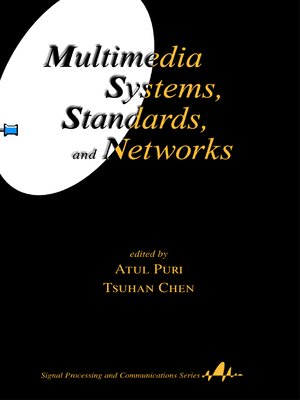Multimedia Systems, Standards, and Networks
ebook ∣ Signal Processing and Communications Series, Book 2
By Atul Puri

Sign up to save your library
With an OverDrive account, you can save your favorite libraries for at-a-glance information about availability. Find out more about OverDrive accounts.
Find this title in Libby, the library reading app by OverDrive.



Search for a digital library with this title
Title found at these libraries:
| Library Name | Distance |
|---|---|
| Loading... |
Highlights new multimedia standards and technologies that enable next generation videoconferencing, mobile video, interactive TV, Internet multimedia, computer games, and digital library applications.
This cutting-edge compendium demonstrates encoding individual audio and video objects in a scene for flexibility of manipulation and scalability...how to compress audio and video data efficiently...composing scenes and modifying based on user interaction...how to search and retrieve digital multimedia content...and how to represent and deliver multimedia in networked applications, ubiquitously and with high quality.
The book provides an in-depth examination of technology offered by key standards and
the International Telecommunication Union-Telecommunication (ITU-T)’s videoconferencing standards, as well as the International Standards Organization (ISO)’s Moving Picture Experts Group (MPEG) standards.
Presents detailed explication of coding algorithms, their performance aspects, choices between competing solutions, and their use in developing applications and services.
Written by over 70 world-renowned experts-many of whom are key contributors to the development of global standards-Multimedia Systems, Standards, and Networks
- showcases popular multimedia standards such as the ITU H.26x Series, ISO MPEG-4, and MPEG-7
- discusses architecture, protocols, audio/video compression, and other components of the H.323 and H.324 standards
- surveys similarities and differences betweeen newer and older standards in the same area
- covers object-based coding and the flexibility it offers for representation and access
- explains several classes of functionalities such as compression efficiency, content-based interactivity, and universal access
- introduces MPEG-4 Visual coding such as natural image/video and synthetic (animation) coding
- details various key parts of the MPEG-4 multimedia coding standards such as MPEG-4 Visual, MPEG-4 Audio, MPEG-4 Systems, and MPEG-4 DMIF
- highlights scene description, composition, and user interactivity aspects of MPEG-4
- explores work in progress in MPEG-7 multimedia description standards on topics such as descriptors, description schemes, and description definition language (DDL)
- investigates tools in MPEG-4 and MPEG-7 that enable novel applications such as mobile video, Internet multimedia, and digital library
- and much more!







